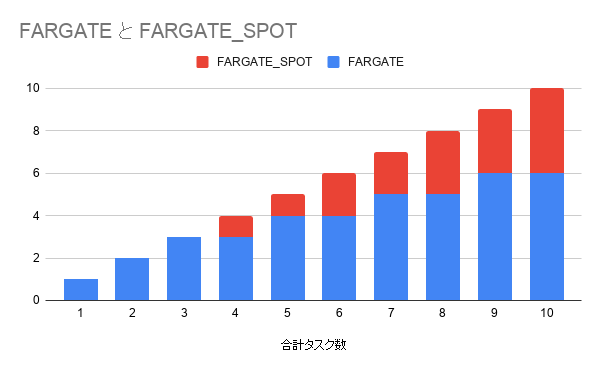- autoscaling全般についてはなします
- terraformのコードがいっぱい出てきます
- application autoscaling
- capacity provider strategy
- launch template
autoscalingには2種類ある
- autoscaling(無印)
- ec2のみ
- application autoscaling
- ecs
- EMR
- ec2
- appstream
- dynamodb
- rds
- sagemaker
- custom-resource
- comprehend
- lambda
- cassandra
autoscalingできる対象は以下
- ecs:service:DesiredCount
- lambda:function:ProvisionedConcurrency
- elasticmapreduce:instancegroup:InstanceCount
- ec2:spot-fleet-request:TargetCapacity
- sagemaker:variant:DesiredInstanceCount
- dynamodb:table:ReadCapacityUnits
- dynamodb:table:WriteCapacityUnits
- dynamodb:index:ReadCapacityUnits
- dynamodb:index:WriteCapacityUnits
- rds:cluster:ReadReplicaCount
- appstream:fleet:DesiredCapacity
- custom-resource:ResourceType:Property
- comprehend:document-classifier-endpoint:DesiredInferenceUnits
- cassandra:table:ReadCapacityUnits
- cassandra:table:WriteCapacityUnits
- Simple scaling
- 1 つのスケーリング調整値に基づいて、グループの現在の容量を増減させます。
- 範囲でもなくalarmをsubscribeしたらそのとおりに実行
- application autoscalingでは使えない(無印だけ)
- 1 つのスケーリング調整値に基づいて、グループの現在の容量を増減させます。
- Step scaling
- アラーム超過のサイズに応じて変動する一連のスケーリング調整値 (ステップ調整値と呼ばれる) に基づいて、グループの現在の容量を増減させます。
- メトリクスの範囲に応じて台数を増減させる
- 例.SQSの数が1ならworkerを+1、10なら+3, 100なら+5
- Target tracking scaling
- 特定のメトリクスのターゲット値に基づいて、グループの現在の容量を増減させます。
- 例.CPU利用率のターゲット値が75なら, 75に近くなるようなscalingをする
- CPU利用率90なら台数を増やす
- CPU利用率60なら台数を減らす
- ChangeInCapacity
- 増減数を指定する
- +1, -1など
- ExactCapacity
- 固定された台数の指定
- 10台、100台など
- PercentChangeInCapacity
- 増減数をパーセンテージで指定
- Desired Capacity : 4 / Scaling Adjustment : 50% の場合、2台増加する
- Desired Capacity : 4 / Scaling Adjustment : -50% の場合、2台減らす
Simple scaling, Step scalingで指定可能
resource "aws_appautoscaling_target" "dynamodb_table_read_target" {
max_capacity = 100
min_capacity = 5
resource_id = "table/tableName"
scalable_dimension = "dynamodb:table:ReadCapacityUnits"
service_namespace = "dynamodb"
}
resource "aws_appautoscaling_policy" "dynamodb_table_read_policy" {
name = "DynamoDBReadCapacityUtilization:${aws_appautoscaling_target.dynamodb_table_read_target.resource_id}"
policy_type = "TargetTrackingScaling"
resource_id = aws_appautoscaling_target.dynamodb_table_read_target.resource_id
scalable_dimension = aws_appautoscaling_target.dynamodb_table_read_target.scalable_dimension
service_namespace = aws_appautoscaling_target.dynamodb_table_read_target.service_namespace
target_tracking_scaling_policy_configuration {
predefined_metric_specification {
predefined_metric_type = "DynamoDBReadCapacityUtilization"
}
target_value = 70 # DynamoDBReadCapacityUtilizationが70に近づくようにscalingする
}
}
dynamo DBは以下に対応している
- table:ReadCapacityUnits
- table:WriteCapacityUnits
- index:ReadCapacityUnits
- index:WriteCapacityUnits
- RDS(Aurora)のread replicaを動的にするautoscaling
resource "aws_appautoscaling_target" "replicas" {
service_namespace = "rds"
scalable_dimension = "rds:cluster:ReadReplicaCount"
resource_id = "cluster:${aws_rds_cluster.example.id}"
min_capacity = 1
max_capacity = 15
}
resource "aws_appautoscaling_policy" "replicas" {
name = "cpu-auto-scaling"
service_namespace = aws_appautoscaling_target.replicas.service_namespace
scalable_dimension = aws_appautoscaling_target.replicas.scalable_dimension
resource_id = aws_appautoscaling_target.replicas.resource_id
policy_type = "TargetTrackingScaling"
target_tracking_scaling_policy_configuration {
predefined_metric_specification {
predefined_metric_type = "RDSReaderAverageCPUUtilization"
}
target_value = 75
scale_in_cooldown = 300
scale_out_cooldown = 300
}
}
resource "aws_appautoscaling_target" "ecs_target" {
max_capacity = 4
min_capacity = 1
resource_id = "endpoint/my-end-point/variant/KMeansClustering"
scalable_dimension = "sagemaker:variant:DesiredInstanceCount"
service_namespace = "sagemaker"
}
resource "aws_appautoscaling_policy" "sagemaker" {
...
}
resource "aws_appautoscaling_target" "ecs_target" {
max_capacity = 4
min_capacity = 1
resource_id = "service/clusterName/serviceName"
scalable_dimension = "ecs:service:DesiredCount"
service_namespace = "ecs"
}
resource "aws_appautoscaling_policy" "ecs_policy" {
name = "scale-down"
policy_type = "StepScaling"
resource_id = aws_appautoscaling_target.ecs_target.resource_id
scalable_dimension = aws_appautoscaling_target.ecs_target.scalable_dimension
service_namespace = aws_appautoscaling_target.ecs_target.service_namespace
step_scaling_policy_configuration {
adjustment_type = "ChangeInCapacity"
cooldown = 60
metric_aggregation_type = "Maximum"
step_adjustment {
metric_interval_upper_bound = 0
scaling_adjustment = -1
}
}
}
- autoscalingの対象はserviceであり, task definitionではない
resource_id = "service/clusterName/serviceName" scalable_dimension = "ecs:service:DesiredCount" - serviceを使うようなweb serviceやagent型の場合に適用できる
- ワンショットで実行するようなbatchでは使えない。
- ECSにおけるタスク実行のインフラをより柔軟に設定する新しい仕組み
- ECSのタスクを実行するインフラを決定する
- EC2:Auto Scaling Group
- Fargate:FARGATE, FARGATE_SPOT
- ECSのautoscalingは以下の2段階
- containerのautoscaling => application autoscaling
- nodeのautoscaling => 無印autoscaling
resource "aws_ecs_cluster" "fargate" {
name = "fargate_cluster"
capacity_providers = [
"FARGATE",
"FARGATE_SPOT",
]
# 100% spotで普段は0台
default_capacity_provider_strategy {
capacity_provider = "FARGATE_SPOT"
base = 0
weight = 1
}
}
resource "aws_ecs_cluster" "fargate" {
name = "fargate_cluster"
capacity_providers = [
"FARGATE",
"FARGATE_SPOT",
]
# 停止できないので2台はオンデマンドで立てておく
# 残りは50%ずつの割合(weightが1:1)
default_capacity_provider_strategy {
capacity_provider = "FARGATE"
base = 2
weight = 1
}
default_capacity_provider_strategy {
capacity_provider = "FARGATE_SPOT"
base = 0
weight = 1
}
}
- EC2の場合はautoscaling groupと紐付けて使う
# clusterがcapacity providerを複数指定
# run-taskの引数としても指定可能なのでその際にfargateかec2を選択する事もできる
resource "aws_ecs_cluster" "this" {
name = "my-cluster"
capacity_providers = [aws_ecs_capacity_provider.this.name]
# default_capacity_provider_strategyで指定されなかった場合のcapacity_providerを決められる
default_capacity_provider_strategy {
capacity_provider = aws_ecs_capacity_provider.this.name
base = 0
weight = 1
}
}
# capacity_providerでautoscaling groupを指定する
resource "aws_ecs_capacity_provider" "this" {
name = "my-capacity-provider"
auto_scaling_group_provider {
auto_scaling_group_arn = aws_autoscaling_group.this.arn
managed_scaling {
minimum_scaling_step_size = 1
maximum_scaling_step_size = 1
status = "ENABLED"
}
}
}
resource "aws_autoscaling_group" "this" {
...
}
- podをscaleさせる前にかならずinstanceをscaleさせる必要がある
- instanceがない状態でrun-task(containerを起動)してもエラー
- instanceが0台で起動していない状態でrun-taskすると、
- containerがpendingになる
- capacity providerがautoscaling groupにresourceを要求
- intanceが起動
- containerもrunningになる
- 2019年末に出た機能
- インスタンスタイプの重み付けができるようになった
- 要求スペックに近い状態が維持しやすくなり、コストが抑えやすい
resource "aws_autoscaling_group" "this" {
name = "my-autoscaling"
min_size = 10
max_size = 100
vpc_zone_identifier = ["subnet-xxxxxxxxx"]
mixed_instances_policy {
launch_template {
launch_template_specification {
# launch templateのIDを指定
# ここでsubnetを指定していても、autoscalingのsubnetが使われる
launch_template_id = "lt-xxxxxxxxxxxxx"
}
instances_distribution {
# オンデマンドで作る絶対数
# この場合ベースラインのインスタンス台数は0台
on_demand_base_capacity = 0
# オンデマンドの比率
# 0ならオンデマンド:spotが0:100になるのでspotでしか起動しない
on_demand_percentage_above_base_capacity = 0
}
# c5.xlargeはインスタンス1台とみなされる
override {
instance_type = "c5.xlarge"
weighted_capacity = "1"
}
# c5.2xlargeはインスタンス2台とみなされる
override {
instance_type = "c5.2xlarge"
weighted_capacity = "2"
}
# c5.4xlargeはインスタンス4台とみなされる
override {
instance_type = "c5.4xlarge"
weighted_capacity = "4"
}
}
}
}
この場合、c5.12xlargeを多めにしたほうがトータルコストは安くなる
| インスタンスタイプ us-east-1a | AZでのスポットインスタンス料金 | 重み | 1重みあたりのコスト |
|---|---|---|---|
| c5.xlarge | $0.090 | 1 | $0.090 |
| c5.2xlarge | $0.180 | 2 | $0.090 |
| c5.4xlarge | $0.341 | 4 | $0.085 |
| c5.12xlarge | $0.779 | 12 | $0.065 |
| c5.18xlarge | $1.207 | 18 | $0.067 |
| c5.24xlarge | $1.555 | 24 | $0.065 |
- instanceを起動するための設定を詰め込んだtemplate
- ただのtemplateでしかないので課金はされない
- 予めterraformなどでtemplateを用意しておき、開発者に起動してもらう
- 起動させる詳細情報などを入れておき、開発者に細かい起動optionを意識させない事ができる
- AMIのID
- subnet
- security group
- IAM Role
- 普通にrun-instanceさせると誤起動の可能性がある
- SGフル開放のinstance起動しちゃったり、、
- iam roleがなくて何もアクセスできないinstanceが起動したり
- 起動させる詳細情報などを入れておき、開発者に細かい起動optionを意識させない事ができる
- autoscaling groupに使う
- launch configurationは今では非推奨
- autoscaling以外で使えないし、、
- replace方法
- https://docs.aws.amazon.com/autoscaling/ec2/userguide/replace-launch-config.html
- EKSのmanaged nodegroupもlaunch templateが使われてたりする
- launch configurationは今では非推奨
run-instance(ec2の起動)にも使える
$ aws ec2 run-instances \
--launch-template LaunchTemplateName=ubuntu18-base
パラメータの上書きもできる
$ aws ec2 run-instances \
--launch-template LaunchTemplateName=ubuntu18-base \
--instance-type m6g.medium
うまく上書きできないoptionもあるので注意。
autoscalingに使えるlaunch templateの制限
- networkの設定が1つ(1subnet)
- ondemand起動(spotではない)
他にもあるかも
terraformだとこんな感じ
resource "aws_launch_template" "ubuntu18-base" {
name = "ubuntu18-base"
block_device_mappings {
device_name = "/dev/sda1"
ebs {
encrypted = false
delete_on_termination = true
volume_type = "gp2"
volume_size = 20
}
}
disable_api_termination = false
iam_instance_profile {
name = "test"
}
image_id = "ami-xxxxxxxx"
instance_market_options {
market_type = "spot"
}
instance_type = "t2.micro"
key_name = "test"
monitoring {
enabled = true
}
network_interfaces {
subnet_id = "subnet-xxxxxxxxx"
delete_on_termination = true
associate_public_ip_address = false
security_groups = ["sg-12345678"]
}
tag_specifications {
resource_type = "instance"
tags = {
Service = "foo"
Roles = "ubuntu18:base"
}
}
user_data = filebase64("${path.module}/provisioning.sh")
}

